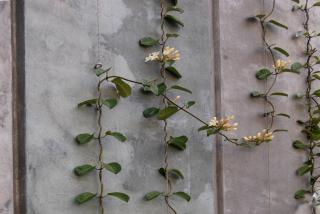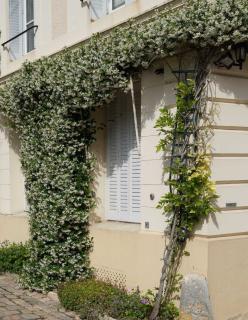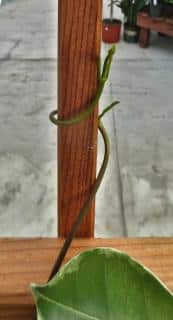

Stephanotis is a fabulous fragrant vine. Both blooms and leafage are magnificent. Where the climate permits, it’s the perfect flower vine to train up a lattice or trellis! Here arethe steps to make this happen.
This is one of the most fragrant summer bloomers. Training your Madagascar jasmine along an arbor near a passage will let all your visitors feel giddy with the beautiful scent!
Height – 10 to 16 feet (3 to 5 meters), as long as the weather is suitable (over 55°F or 13°C)
Let’s get started on how to train a Stephanotis vine along a wall or arbor.
Read also:
If you’re aiming to cover an entire wall with this wonderful vine, it’s perfectly possible. Your best option is to create a grid with 1-foot (30 cm) vertical intervals. It’s also helpful to include horizontal lines as well, but it isn’t mandatory.
For arbors and arches, it’s better to reduce the space between lines to ½ foot (15 cm). This makes it easier to weave the plant in and out of the structure.
 Ideal would be specially-designed sets of stainless steel stranded wires that connect to strong lugs fastened to the wall.
Ideal would be specially-designed sets of stainless steel stranded wires that connect to strong lugs fastened to the wall.It’s also good to make a self-supporting lattice, but you must consider the following:
Think strong: when fully grown and loaded with leaves, your Stephanotis can easily reach a hundred pounds (50 kg) or more in weight. Fasteners should be adequately installed in holes drilled into the wall.
After having set up your lattice, you can prepare the soil for the root ball.
 Dig a hole at least twice as large as the root clump at the foot of the lattice. Add the layer of drainage, and then pile a small mound of soil mix and garden soil mixed together. You can add a couple handfuls of ripe compost into the mix.
Dig a hole at least twice as large as the root clump at the foot of the lattice. Add the layer of drainage, and then pile a small mound of soil mix and garden soil mixed together. You can add a couple handfuls of ripe compost into the mix. Stephanotis is a twining vine. It twists around twigs and stems like a snake. It doesn’t produce tendrils (such as the ones squash or passion fruit might have), nor does it have the sticky rooting hairs that ivy has.
Stephanotis is a twining vine. It twists around twigs and stems like a snake. It doesn’t produce tendrils (such as the ones squash or passion fruit might have), nor does it have the sticky rooting hairs that ivy has.
At the beginning, you have to attach it to the lattice. As the vine grows, weave it around and around the slats, wires or strings. It’ll naturally follow thinner strings, but if the slats are too wide you’ll have to adjust growth yourself.
Best is to tie the plant loosely with a biodegradable string such as hemp or raffia. By the time it falls off, the plant will have already moved on. That way there’s no risk of choking the plant.
After the first two years, it’s best to start giving the plant fertilizer on a twice-yearly basis (end of winter and end of spring). Any balanced fertilizer will do, but prefer flower plant fertilizer if you can.
As for the shape and the pruning, follow the guidelines in this article on pruning stephanotis.
Ultimately, the goal is to form a few thick, strong structural branches that are permanent. And every year or every two years, cut back any secondary branches back to the trunk. New growth will form constantly and flower from end of spring until the end of summer.